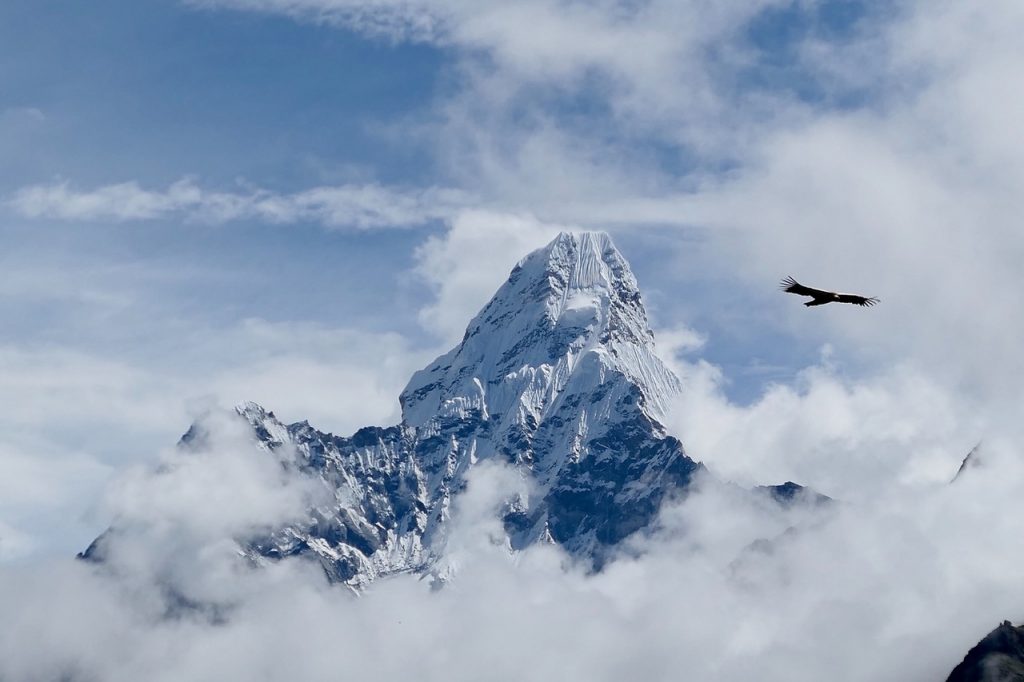Peak Experiences
(by Ninja) The Himalaya, Sanskrit for “abode of snow”, comprises a series of 3 parallel mountain ranges running across or bordering India, China, Tibet, Bhutan, Pakistan, Afghanistan, and Nepal. Nine of the world’s 10 highest peaks are here, with the exception of K2 lying in the neighboring Karakoram range. The ranges run from east to west for over 1500 miles.

The Himalayas are revered by Buddhists and in particular, Vajrayana Buddhism has flourished there, for meditation, retreat, and perhaps to meet an enlightened master. This is where Rama met Master Fwap, as we learn in “Surfing the Himalayas”, and where Padmasambhava brought Buddhism from India in the eighth century, founding the Nyingma school of Tantric Buddhism. Milarepa, a famous Tibetan teacher of the 11th century, was a dark sorcerer as a young man who went on a vengeful killing spree before meeting his teacher Marpa the Translator, and eventually becoming fully enlightened. The immortal enlightened teacher Babaji is believed to still roam the Himalayas, teaching Kriya yoga to any who can find the “deathless guru”.
These mountains are also prized by world-class mountaineers, and both life and limb have often been sacrificed in pursuit of the high Himalayan peaks.
In any discussion of Buddhism and the Himalayas, the specter of the crimes that have been and are being committed in Tibet is raised. Beginning in 1950 the Chinese Red Army took over the central and western regions of this large country (970,000 mi.², larger than Alaska and California combined). They ransacked and destroyed Buddhist monasteries. Monks and nuns who refused to forsake the Dalai Lama were tortured and killed. Many, many more were imprisoned for what they believed, and more than 1 million Tibetans have died as a direct result of China’s invasion.
While Buddhism continues to be the primary religious practice in the higher reaches of the Himalayas, i.e., the northern range known as the Greater Himalaya, its spiritual leaders are in exile, imprisoned, or dead. While this is certainly one of the great injustices of our time, it remains to be seen what effect the strategy of peaceful resistance taken up by the Dalai Lama will ultimately produce.
Rama (Dr. Frederick Lenz) often spoke of the Himalayas, not just because of his close association with the region both in this life and previous lives, but also to reflect on the profound stillness and purity found there which make it so much easier to meditate and stop thought. In his talk entitled “Wisdom” in the Enlightenment Cycle talk series, he says, “Let’s say you go to the Himalayas and you’re drawn to tops of mountains. You climb way up through the ice and the snow and you get to the top of K2 or Mount Everest or mountains that perhaps are not as well known. You get up there. You stand there and you see the ranges, of the mountains, the Himalayas spread out at your feet. And it’s different there. There’s a different feeling there. There’s a different awareness there. It vibrates very fast. The mountains themselves and the dimensions that are associated with those mountains vibrate very quickly.”
“You are up there in the realm of the eternal snows, and then you come back down. And then when you’re down here, you sort of forget about what happened up there, what those experiences and feelings were like. You go back to life and your house and your job and what you do. But it changes you. It clarifies your purpose. It makes life more abundant to have had that experience. It’s not transient. It’s eternal. You touch eternality at the top of the Himalayas.”
Getting to the top of the Himalayas is the challenge, and whether we do so inwardly or as part of a pilgrimage, or on a trek with other intrepid mountaineers, a great amount of self-effort is required. The inspiration for such a quest is fortunately readily available.
The film “Himalaya” directed by Eric Valli, an award-winning National Geographic photographer who has spent many years living and working in the Himalayas, was the first Nepalese film to be nominated for Best Foreign Film at the 1999 Academy Awards. It provides provocative insights into traditional Tibetan culture, with all but two of the characters played by real-life villagers, chiefs, and lamas, and the storyline is engaging and exciting. But the real fun for me came on the second viewing when I could focus less on the characters and plot, and more on the textures, sounds, and vistas. The cinematography takes you right into the heart of the mountains. Remarkably, the locations where this film was shot could only be reached by foot and it took the crew nine months to complete shooting.
There are other great sources of inspiration, starting with the spiritual classics “Surfing the Himalayas” and “Snowboarding to Nirvana”. In my next post, we will look at some of those sources and continue the conversation.
